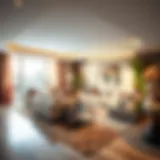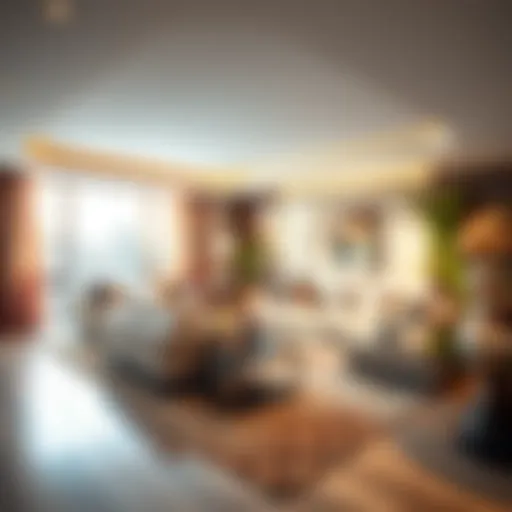Innovations and Impacts of du Masdar City Center
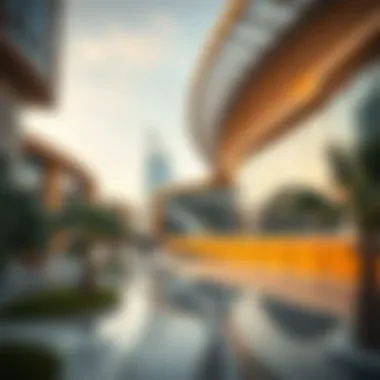
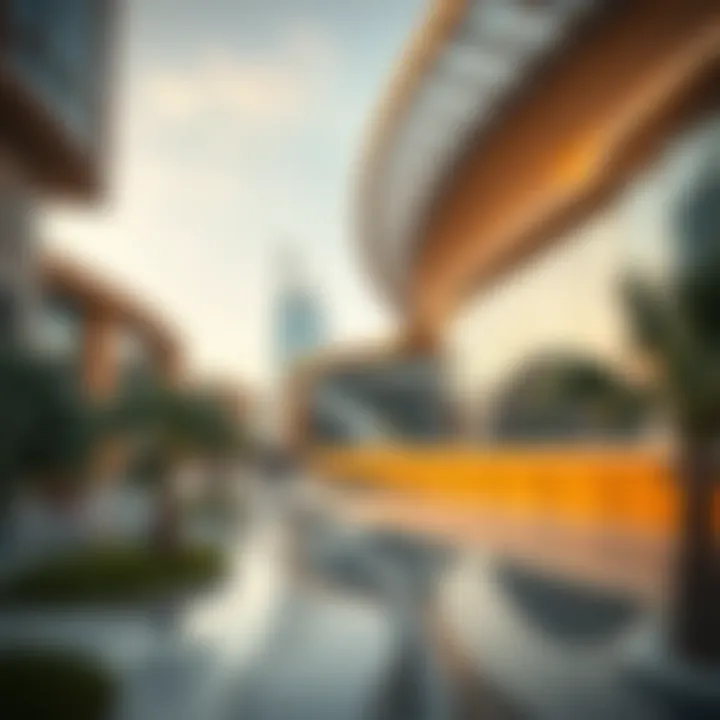
Intro
The du Masdar City Center stands as a testament to innovation in sustainable urban planning. Nestled within the larger eco-city of Masdar in Abu Dhabi, this center is not merely a hub for commerce and social activities; it represents a shift in how we think about urban environments. The design marries cutting-edge technology with sustainability principles, creating a space that is functional yet rooted in ecological responsibility.
With the world facing climate changes and urban pollution, the dynamics of development continuously evolve. In this context, exploring the Masdar City Center reveals significant insights into future real estate trends, community engagement, and architectural resilience. The center is more than a location; it is an incubator for ideas that could shape how we build and live in the years to come.
As we dive into this analysis, we will cover various aspects that highlight the integration of renewable energy systems, architectural innovations, and the socio-economic implications of the center within the broader framework of Masdar City. Our focus includes real estate investors, property agents, and market analysts who are eager to understand the intersection between technology, community, and sustainability in the urban planning arena.
Understanding Masdar City
The emergence of Masdar City extends beyond the mere configuration of urban spaces; it embodies a vision for sustainable living interwoven with the fabric of technological advancement. Understanding its historical background and core objectives provides critical insights into how this modern settlement has shaped and will continue to inform urban development in Abu Dhabi and beyond.
Historical Context
Masdar City’s genesis can be traced back to the early 2000s when the UAE government recognized that the country’s reliance on fossil fuels demanded a long-term strategy for a sustainable future. The initial idea was to create a hub, a nucleus for innovation that could significantly decrease the region's ecological footprint. Founded in 2006 by the Abu Dhabi Future Energy Company, Masdar was envisioned as a landmark project to pioneer renewable energy solutions amidst a rapidly changing climate.
Investing billions into the project, stakeholders intended to attract global talent and industries focused on clean technology. This endeavor aligns with Abu Dhabi’s diversification strategy away from oil dependency, hence positioning Masdar as a research and development epicenter. Over the years, the development of Masdar City has witnessed various phases, adjusting to the changing dynamics of technology and environmental imperatives.
This historical lens is vital as it frames Masdar City not just as a physical location but as a pioneering example of what urban planning can achieve when infused with sustainability principles—especially crucial considering the global climate agenda.
Vision and Goals of Masdar City
At its core, Masdar City strives to be a self-sustaining urban ecosystem, a vision echoed by its master plan. The ambition is far-reaching: to provide a livable environment with zero carbon emissions, primarily achieved through innovative technologies and community-oriented designs. This vision encompasses various goals that serve as guiding stars to its development:
- Sustainability: The reduction of greenhouse gas emissions through sustainable practices.
- Innovation: Establishing a center for research and cutting-edge technology that can propel renewable energy sectors.
- Community Engagement: Fostering a lifestyle that prioritizes environmental consciousness and encourages residents to engage with sustainable methods of living.
Masdar City aims to become a model not just for the Middle East but for global cities grappling with the challenges of climate change and urbanization. It seeks to serve as a blueprint for future developments where urban living can harmonize with nature, ensuring that economic capabilities do not outpace environmental responsibilities.
Understanding Masdar City helps investors, homebuyers, agents, and analysts grasp how the integrated approach—melding historical insights with bold goals—can yield a transformative urban environment, ultimately shaping future real estate opportunities.
The Role of du Masdar City Center
The du Masdar City Center serves as a pivotal component within the broader vision of Masdar City, embodying the principles of sustainable development and innovation. Its importance cannot be overstated, as it integrates cutting-edge technology with community-focused initiatives. As urban areas face increasing pressure from rapid population growth and environmental challenges, the City Center stands out as a beacon, offering insights into how future urban developments can balance economic prosperity with eco-conscious practices.
Central Hub for Innovation
At the heart of the du Masdar City Center lies its function as a central hub for innovation. It brings together a diverse range of businesses, researchers, and entrepreneurs, all aiming to unleash new ideas and technologies that could shape the future of urban living. This blending of intellect and creativity isn't just a byproduct of its design; it is a fundamental goal.
The Center acts as a magnet for industries focusing on renewables and sustainable technologies. For instance, the integration of companies like Siemens and Brookfield has significantly advanced research into smart grid technologies and energy-efficient designs. These partnerships are not merely superficial; they allow for synergistic collaborations that can lead to ground-breaking solutions, ranging from energy storage to eco-friendly construction materials.
"Innovation thrives in collaboration. The community ignites creativity, fostering a spirit of progress unlike anywhere else."
Moreover, the Master Plan includes spaces specifically designed for experimental projects. Startups and established companies alike can leverage testing grounds for their innovations, paving the way for development that could ultimately be implemented on a broader scale outside city limits. The center’s infrastructure promotes this entrepreneurial ecosystem, illustrating Masdar's commitment to an adaptive and resilient urban future.
Integration with Sustainable Practices
Another crucial aspect of the du Masdar City Center is its integration with sustainable practices. The fusion of innovative design with green technologies sets a precedent for urban development standards. The City Center is more than just a space; it’s a living laboratory that displays how sustainability can be woven into every fabric of urban life.
From solar energy solutions to smart waste management, the center utilizes various techniques that prioritize environmental stewardship. For example, the solar panels arranged throughout the center harness renewable energy to reduce reliance on fossil fuels, showcasing practical applications of clean energy. Additionally, rainwater harvesting systems and sustainable landscaping strategies serve to minimize the ecological footprint of the space.
These practices do not exist in isolation; they are part of a broader narrative that emphasizes responsible resource consumption, which is particularly crucial in a region often impacted by scarcity of water and resources. As a result, the effectiveness of these sustainability measures can serve as a proof of concept, providing valuable lessons for other cities grappling with similar issues of resource management.
As more communities strive to incorporate sustainable methodologies into their planning, the City Center offers a compelling case study for urban developers and policymakers.
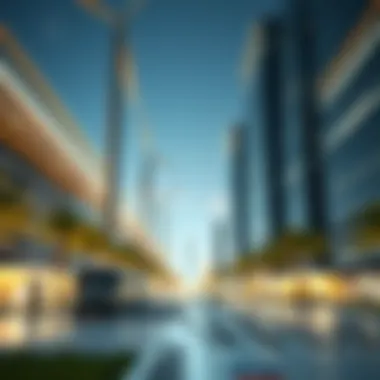
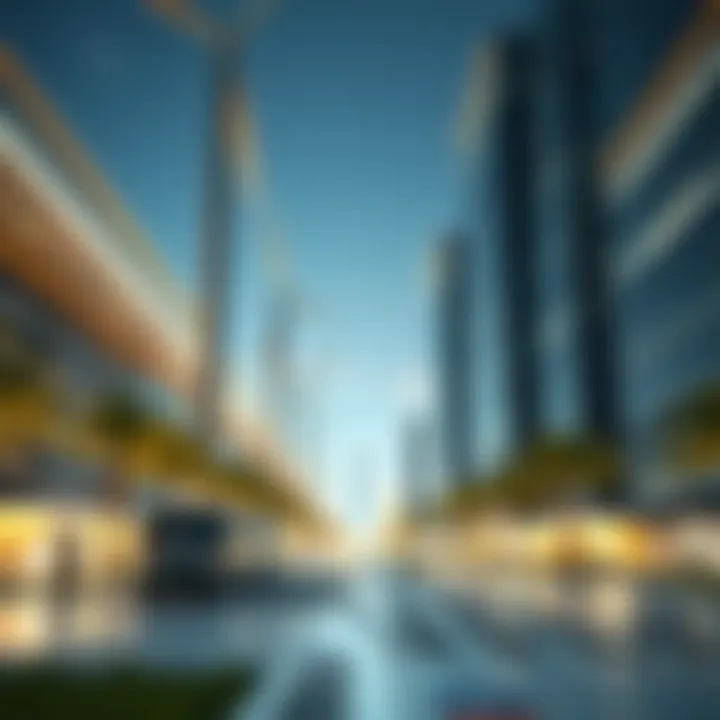
Architectural Design
In the context of du Masdar City Center, architectural design is not merely about aesthetic appeal. It is a critical aspect that shapes the interaction between people and their environment, particularly in a city dedicated to sustainability and innovation. The design choices made in this development reflect a commitment to modernity, functionality, and harmony with natural landscapes.
Contemporary Approaches to Design
Contemporary architectural practices embrace diversity and adapt to cultural and technological advancements. The designs at du Masdar City Center bring together sleek, modern lines with traditional elements that resonate with Abu Dhabi's rich heritage. For instance, the use of local materials and energy-efficient design principles creates buildings that stand out while blending seamlessly into their surroundings.
- Curved Structures: Many buildings feature gentle curves aimed at enhancing airflow, improving energy efficiency. This feature minimizes the amount of heat that enters the buildings, reducing energy consumption.
- Open Spaces: The integration of public spaces, laden with greenery, promotes social interaction and community-building. Open plazas and gardens dotting the city center encourage people to engage with one another, fostering a sense of belonging.
- Adaptability: Flexibility is another notable characteristic of contemporary design here. Buildings can be easily modified to fit different needs or purposes, which is a critical aspect in a rapidly evolving urban landscape.
These approaches not only enhance functionality but also symbolize a cultural shift towards progressive urban living. They challenge traditional views by showing that sustainability and style can go hand in hand.
Environmental Considerations
Incorporating environmental considerations in architectural design is crucial for any sustainable project, and du Masdar City Center is no exception. The center aims to minimize ecological footprints while promoting innovative eco-friendly practices. Here are some key factors:
- Passive Solar Design: Buildings are oriented in a way that maximizes natural light and minimizes reliance on artificial lighting and cooling systems. This design choice not only lowers energy bills but also reduces carbon emissions.
- Water Management: Sustainable water management systems are integrated into the design. Rainwater harvesting and greywater recycling systems ensure that water is used effectively, vital in a region where water scarcity is a pressing issue.
- Native Landscaping: The choice of plants in landscaping is guided by the principle of using native species that thrive in the arid climate. This not only lessens the need for irrigation but also supports local biodiversity.
"Nowhere else are the principles of sustainability and innovative design interwoven as seamlessly as they are in du Masdar City Center. The architectural integrity reflects not only aesthetic values but profound environmental considerations that will serve generations to come."
Technological Innovations
In the realm of sustainable urban development, technological innovations serve as the backbone of progress and transformation. In the context of du Masdar City Center, these innovations are pivotal not only for enhancing the efficiency of operations but also for fostering an environment that prioritizes sustainability. This section will delve into specific elements such as smart technologies and renewable energy initiatives, underlining their benefits and the considerations that stakeholders must take into account.
Smart Technologies Implementation
The implementation of smart technologies at the du Masdar City Center heralds a new age of urban living. This is not merely about having fancy gadgets or cutting-edge software; it’s about creating interconnected systems that improve quality of life while minimizing environmental impact.
- Integration with IoT: Smart technologies, particularly through the Internet of Things (IoT), enable various systems to communicate with one another. For example, smart sensors monitor energy usage and adjust lighting and heating in real-time. This data-driven approach not only cuts energy consumption but enhances user comfort.
- Data Analytics: Advanced data analytics plays a crucial role in optimizing resources. By analyzing trends, city planners and businesses can forecast demands and adapt services accordingly, resulting in better resource allocation and more sustainable practices.
Moreover, with real-time data monitoring, decisions can be made quickly, leading to more responsive urban management. As a case in point, the smart waste management system in place utilizes sensors to detect fill levels in bins, thus streamlining collection routes and reducing emissions from waste collection vehicles.
Renewable Energy Initiatives
At the heart of the du Masdar City Center lies a robust framework of renewable energy initiatives. These initiatives are essential not just for powering the center but for demonstrating a model of sustainable energy production.
- Solar Energy Integration: The center is equipped with high-efficiency solar panels that provide a substantial amount of its energy needs. This initiative sets a precedent; not only does it supply clean energy, but it also significantly reduces reliance on fossil fuels, contributing to a substantial decrease in carbon emissions.
- Energy Sharing Systems: Implementing energy-sharing systems allows buildings within Masdar City to benefit from a collective energy pool. When energy production exceeds consumption in one area, excess energy can be redistributed to another section requiring more power. This is a revolutionary step towards energy resilience.
- Biodiversity-Friendly Practices: Renewable energy initiatives at the center are designed not only to produce energy but also to protect local ecosystems. The installation and maintenance of renewable energy sources are conducted in a way that minimizes impact on the surrounding wildlife and plants.
"The future of energy is as much about conservation and efficiency as it is about generation."
In summary, the overarching importance of technological innovations in du Masdar City Center is evident. They are quintessential to its role as a hub for sustainable urban futures, providing a clear direction for real estate investors, property agents, and urban planners. By focusing on smart technologies and renewable energy initiatives, stakeholders can glean insights into the best practices that may well become the gold standard in urban development globally.
More insights on technological innovations can be explored in depth at Britannica, Wikipedia, and industry-focused forums such as Reddit.
Community Engagement
Community engagement stands as a cornerstone in the development of du Masdar City Center, embodying the very essence of collective growth and innovation. The importance of community involvement cannot be overstated, especially in a city that aims to be a model for sustainable living. Engaging residents and stakeholders fosters a sense of ownership and pride, creating a vibrant community that actively participates in shaping its own future. In Masdar City, where sustainability meets cutting-edge technology, the integration of community engagement ensures that initiatives align with the needs and aspirations of its diverse population.
Through direct interaction, the Masdar City Center has developed programs that not only inform but also involve individuals in decision-making processes, thus supporting holistic development. This two-way street encourages innovation and can lead to unexpected breakthroughs that only a connected community can foster. Moreover, engaged residents often contribute ideas that can be transformed into viable projects, enriching the overall life in the city.
Fostering Community Growth
Fostering community growth in Masdar City involves a blend of strategic development and grassroots initiatives. The du Masdar City Center serves as more than just a hub for innovation; it is a catalyst for social cohesion. By prioritizing community aspirations, the center creates spaces for collaboration and connection among residents.
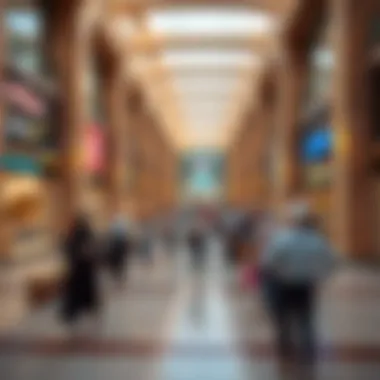
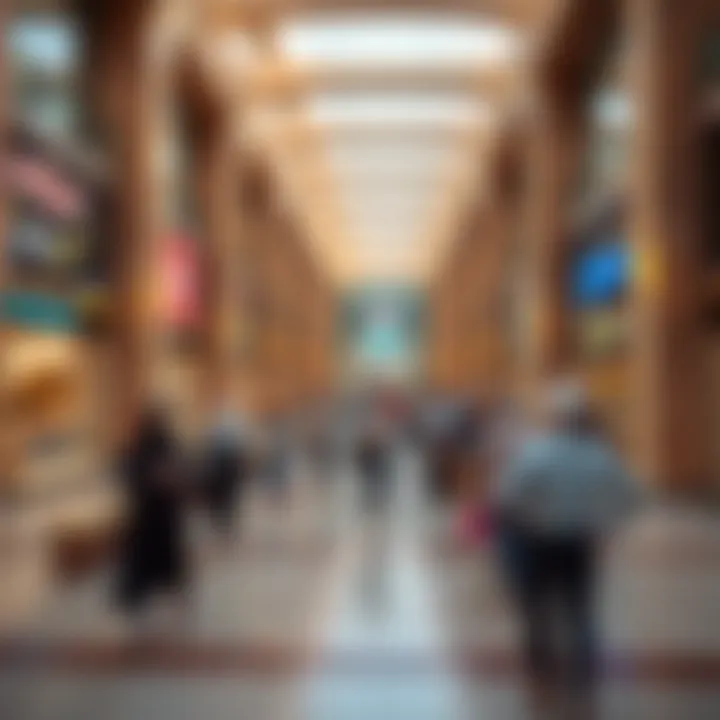
- Inclusion and Diversity: Addressing the needs of a multicultural population is vital. Each demographic brings unique perspectives. Engaging diverse voices ensures that all corners of the community are considered in development projects.
- Educational Programs: Education is paramount for growth. Workshops, seminars, and hands-on experiences provided at the center not only raise awareness but also empower residents to advocate for sustainability. These programs bridge gaps between knowledge and action.
- Economic Opportunities: Local businesses are given preference in various initiatives, fostering entrepreneurship. The center supports startup incubators that help locals establish their ventures, providing mentorship and resources to fuel their growth.
Ultimately, fostering community growth is about nurturing an ecosystem where every voice is heard, allowing the community to thrive both socially and economically.
Events and Activities at the Center
The events and activities held at the du Masdar City Center play a crucial role in enhancing community spirit and engagement. They serve not only as entertainment but as platforms for education, collaboration, and sustainability advocacy.
- Sustainability Workshops: Regular workshops focusing on sustainable practices educate residents on how they can contribute to the city's goals at home. From composting to water conservation, these sessions equip participants with practical skills.
- Cultural Festivals: Celebrating the multicultural tapestry of Masdar City, cultural festivals bring together residents for food, music, and art, creating moments of joy and connection that strengthen community ties.
- Innovative Expos: Showcasing technological advancements, these expos encourage interaction between innovators and the community. They serve to inspire residents while also providing a platform for businesses to network and collaborate.
Engaging community events not only highlight sustainability initiatives but also ensure the community remains dynamic and involved in the evolution of their environment.
Through these varied activities, the du Masdar City Center reinforces its commitment to creating a thriving, engaged community—a key ingredient in the recipe for successful urban development.
Real Estate Implications
In the context of du Masdar City Center, the discussion around real estate implications stands central to understanding how this urban development is shaping both local and global property markets. The unique elements of Masdar City, ranging from its sustainable practices to cutting-edge technology, have created a real estate narrative that warrants thorough examination.
When analyzing the real estate factors associated with Masdar City, several benefits and considerations come to light. Firstly, the desirability of living and working in an eco-friendly environment is on the rise. Buyers and tenants increasingly seek spaces that not only offer quality amenities but also embrace sustainability. Masdar City, with its dedication to renewable energy and cutting-edge building practices, positions itself as a prime candidate in fulfilling this demand.
Another significant aspect is the positive impact on property values. With the global shift towards sustainable living, properties within Masdar City are likely to appreciate over time. The unique nature of the center encourages eco-conscious consumers to invest in real estate, bolstering the market. A focus on sustainability could serve as a catalyst in raising property prices, making this a keen interest for investors.
Additionally, the urban layout and design of the city encourage a healthy lifestyle. With walkable spaces, parks, and a community-centric approach, Masdar City fosters an attractive environment for families and professionals alike. The benefits of such living conditions add another layer of appeal to potential buyers.
However, there are challenges that investors must consider. The integration of advanced technology and sustainable practices may lead to higher initial costs for property developers. Navigating the financial implications of such investments calls for careful planning and consideration of long-term gains against initial outlays.
"Understanding the evolving landscape of real estate within sustainable urban centers requires a blend of foresight and strategic planning."
Investors and property agents are encouraged to look closely at market fluctuations and buyer preferences that are evolving alongside sustainability trends. This market analysis is not just about numbers; it’s about understanding the heart of Masdar City and the transformative potential it holds for the future of real estate.
Market Analysis of Masdar City
The market analysis of Masdar City reveals a unique ecosystem where innovation and sustainability intertwine, creating a vibrant real estate landscape. As UAE continues to grow as a focal point for investors, understanding the commercial and residential market segments within Masdar City is vital.
Current data suggests a bullish trend in property demand within the city limits. According to industry sources, there are several key market indicators that showcase the potential:
- Increased Foreign Investment: There’s a noticeable uptick in interest from international investors aiming to capitalize on sustainable urban development.
- Rising Property Values: Trends indicate that property prices in Masdar City are steadily appreciating, bolstered by government incentives focused on sustainability.
- Demand for Mixed-Use Developments: With thriving communities springing up, there’s a stronger preference for properties that seamlessly integrate residential, commercial, and recreational spaces.
However, challenges like regulatory hurdles and construction costs remain barriers to entry for some investors. Comprehensive research and risk assessments are essential for facilitating success in this evolving market.
Investment Opportunities
Investment opportunities within du Masdar City Center are expansive and promising. Given its unique positioning at the intersection of sustainability and technology, several avenues are ripe for exploration:
- Commercial Real Estate: Offices and retail spaces tailored to environmentally conscious businesses are in demand, offering unique opportunities for investors.
- Sustainable Housing Projects: With increasing consumer awareness around climate and living conditions, opportunities to develop energy-efficient residential properties are gaining traction.
- Technology Ventures: Collaboration with tech firms focusing on sustainable innovations provides investment opportunities that can yield high returns as the market grows.
Ultimately, Masdar City’s focus on sustainability opens doors for a new narrative in real estate—one where investors can not only witness profitable returns but also contribute to a globally beneficial movement. As these market dynamics continue to shift, being equipped with the right insights can significantly enhance decision-making for investors and stakeholders alike.
Challenges and Opportunities
In the heart of Abu Dhabi lies the du Masdar City Center, a manifestation of innovation that's continuously confronting the dual forces of challenges and opportunities. Understanding these dynamics is crucial for investors and stakeholders. The focus here is not just to identify obstacles but to highlight pathways that could lead to sustainable growth and profitability.
Environmental and Economic Challenges
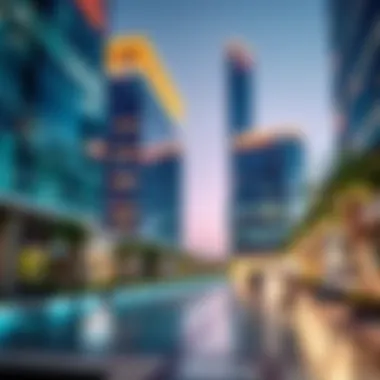
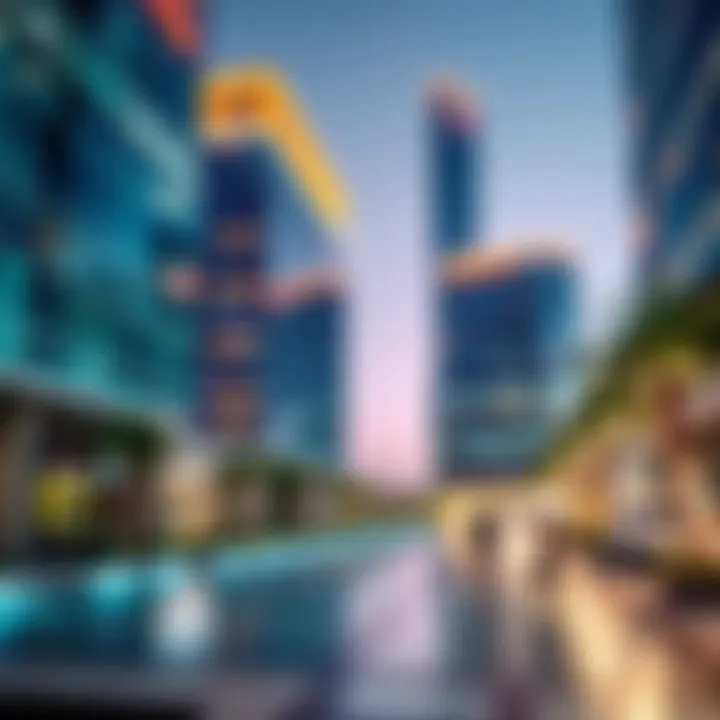
The environmental and economic challenges are significant, especially within the context of urban development. For instance, the climate in Abu Dhabi presents substantial hurdles for sustainable construction. Intense heat and sandstorms can hinder the effectiveness of even the most advanced renewable energy systems. The reliance on solar power, while advantageous, necessitates ongoing maintenance and innovation to ensure efficiency.
Economically, there are questions around return on investments in projects that prioritize sustainability over immediate profit. Real estate investors are often wary of investing in ventures that may not provide quick returns. With the fluctuating global oil prices, there’s a heavy dependence on economic stability in the region, which can make long-term planning challenging.
"Developing sustainability is about striking a balance between environmental stewardship and economic stability."
In addition to these factors, community acceptance plays a role. Not every innovation resonates with the local populace. The challenge is to create solutions that harmoniously fit within the cultural and social fabric of the community. If the benefits of new technologies or developments aren't readily visible, gaining public support can be an uphill battle.
Future Growth Prospects
Despite the challenges, there is a silver lining. The prospects for the future growth of the du Masdar City Center remain bright. As global awareness around climate issues increases, sustainable developments like Masdar City are becoming increasingly attractive. Investors looking to tap into green technologies have the unique opportunity to become pioneers in a growing market. Cities worldwide are scrambling to adopt sustainability practices, which increases the potential for Masdar City to serve as a model.
From a technological perspective, advancements in energy storage solutions promise to bolster the effectiveness of renewable projects. As developments in battery technology and smart grid systems progress, the center could become a hub of innovation, drawing attention and investment.
Furthermore, collaborating with universities and research institutions can provide opportunities for talent development and innovative solutions. Involving local communities in decision-making processes can also yield rich insights into what residents want.
The evolving landscape opens doors for collaborations with international firms specializing in sustainable technologies, positioning the du Masdar City Center as a leading example of what the future of urban living could resemble.
It's clear that while challenges abound, the opportunities for growth and innovation are equally, if not more, numerous. Investors willing to navigate this landscape could find themselves at the forefront of a transformative movement in urban development.
Comparing Global Models
The significance of comparing global models in the realm of sustainable urban development cannot be overstated. It serves as a framework where cities across various continents can learn from one another's successes and failures. Cities often grapple with similar issues, such as climate change, population density, and resource management. As such, looking beyond geographical confines allows urban planners and stakeholders to gather effective strategies that can govern real estate, infrastructure, and community well-being.
By investigating the experiences of other sustainable cities, it becomes evident that solutions are often a mosaic of ideas meticulously crafted to meet local demands while still pursuing global sustainability aims.
Lessons from Other Sustainable Cities
Several cities worldwide showcase meaningful strides in sustainability, providing a treasure trove of lessons. For example, Copenhagen distinguishes itself by integrating cycling infrastructure into urban planning. Over 60% of commuters navigate the city by bike, reducing emissions and promoting healthier lifestyles. This approach not only encourages the use of clean transportation but also cultivates a sense of community among residents.
Moreover, in Curitiba, Brazil, innovative public transport solutions, like the bus rapid transit system, have been pivotal in shaping the urban landscape and reducing traffic congestion. The system's efficiency demonstrates the benefits of forward-thinking urban mobility, enabling a reduction in carbon footprints while providing a reliable travel option.
Each of these models provides valuable insights into effective public engagement and resource management—key elements that resonate deeply with the objectives of du Masdar City Center.
Best Practices for Urban Development
When striving for sustainable urban environments, there are a few noteworthy practices that should be prioritized. These include:
- Mixed-Use Development: Combining residential, commercial, and recreational spaces promotes social interaction and reduces the need for long commutes.
- Green Building Standards: Adhering to standards like LEED (Leadership in Energy and Environmental Design) supports energy-efficient building and lower overall environmental impact.
- Community Involvement: Actively engaging residents brings to light their needs and preferences, leading to inclusive and responsive urban planning.
By fostering these practices, cities worldwide can better address the challenges posed by rapid urban growth while ultimately enhancing the quality of life for their inhabitants.
To summarize, the exploration of sustainable models from various global landscapes serves to enlighten urban planning practices and bolster the mission of projects like du Masdar City Center. Each lesson learned and every best practice adopted can construct a solid foundation for steering future urban developments towards sustainable and resilient outcomes.
Final Thoughts
As we wrap up our exploration into du Masdar City Center, it's crucial to reflect on the implications of its innovations and impacts on the wider framework of urban sustainability. This section shines a light on not only the advancements made within the center but also the broader context in which these innovations operate. The importance of sustainable development cannot be overstated, and understanding its future trajectory is essential for all stakeholders involved—whether they be investors, residents, or developers.
The Future of Urban Sustainability
The prospect of urban sustainability is tied to continuous innovation in systems and frameworks designed to create more livable cities. Urban areas are rapidly growing, and cities like Masdar present models that other jurisdictions can aspire to. Our analysis indicates several key trends that could shape the future:
- Integration of Technology: As smart city technologies evolve, the impact on daily living and logistics can lead to unprecedented efficiencies. Real-time data analytics, for example, can assist in managing energy, waste, and transportation—shifting urban living into a more optimized state.
- Community-Centric Approaches: Moving forward, engagement with the community will be vital. Residents and business owners must have a seat at the table in decision-making processes, ensuring that solutions are tailored to their actual needs. This collaboration fosters a more cohesive and sustainable urban life.
- Advancements in Renewable Energy: The shift towards renewable sources is not merely a trend; it’s a necessity. As various energy technologies become cheaper and more efficient, cities worldwide will need to embrace these changes, possibly drawing lessons from Masdar’s pioneering use of solar and wind energy.
- Policy and Regulation Developments: Local and national governments will play a role in shaping urban sustainability. Regulations that encourage greener building practices and incentivize sustainable investments are likely to gain momentum.
Overall, the transition to more sustainable urban environments can help mitigate climate change effects, enhance quality of life, and support economic resilience. It's a complicated dance, yet there’s promise in this movement.
Implications for Investors and Residents
For those looking to invest in or settle within Masdar City, understanding these trends and the center’s role is essential. Here are a few implications worth noting:
- Investment Potential: As sustainable practices gain traction, property values in eco-friendly developments may see an uptick. Investors focusing on sustainability may find Masdar City to be an attractive opportunity, presenting long-term gains as demand for green buildings increases.
- Quality of Life: Residents can anticipate a substantial improvement in living standards. With community engagement fostered by Masdar’s design, a supportive neighborhood environment could enhance social cohesion and overall well-being.
- Market Demand Shifts: There is a growing market demand for sustainable properties. Buyers increasingly prioritize energy-efficient living spaces, anticipating lower utility costs and a reduced environmental footprint.
- Focus on Education and Awareness: Future residents and investors must remain informed about the innovations being implemented—not just in Masdar but globally. Education on sustainability practices can foster deeper appreciation and understanding of the value behind such investments.










